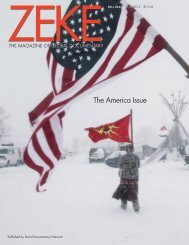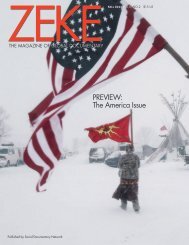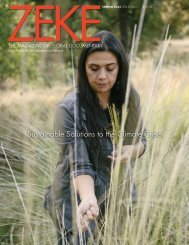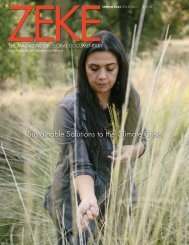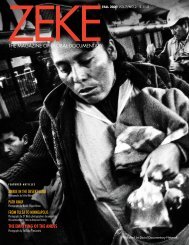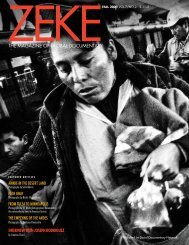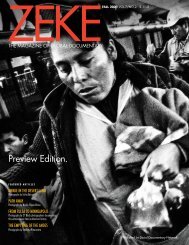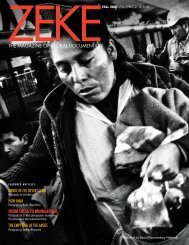ZEKE Fall 2019
Contents includes: "Youth of Belfast" by Toby Binder, and "Delta Hill Riders" by Rory Doyle, winners of ZEKE Award for Documentary Photography "Rising Tides" with photographs by Sean Gallagher, Lauren Owens Lambert, and Michael O. Snyder "Out of the Shadows: Shamed Teen Mothers of Rwanda" by Carol Allen Storey Interview with Lekgetho Makola, Head of Market Photo Workshop, South Africa, by Caterina Clerici "Why Good Pictures of Bad Things Matter" by Glenn Ruga Book Reviews and more...
Contents includes:
"Youth of Belfast" by Toby Binder, and "Delta Hill Riders" by Rory Doyle, winners of ZEKE Award for Documentary Photography
"Rising Tides" with photographs by Sean Gallagher, Lauren Owens Lambert, and Michael O. Snyder
"Out of the Shadows: Shamed Teen Mothers of Rwanda" by Carol Allen Storey
Interview with Lekgetho Makola, Head of Market Photo Workshop, South Africa, by Caterina Clerici
"Why Good Pictures of Bad Things Matter" by Glenn Ruga
Book Reviews and more...
- No tags were found...
Create successful ePaper yourself
Turn your PDF publications into a flip-book with our unique Google optimized e-Paper software.
HOLY<br />
By Donna Ferrato<br />
powerHouse Books, <strong>2019</strong><br />
172 pages | $45.00<br />
International photojournalist Donna<br />
Ferrato has spent her career documenting<br />
domestic terror. Her book<br />
and series, Living With the Enemy<br />
is seminal. Her image, Bengt Hits<br />
Elisabeth,1982, taken while on assignment<br />
for Playboy Japan, was recognized<br />
by TIME magazine as one of the<br />
100 Most Influential Pictures of All Time.<br />
Taken in their New Jersey suburban<br />
home it captures the brutal beating of a<br />
wife by her husband in response to what<br />
he reports was her disobedience. This<br />
experience changed Ferrato’s life and<br />
began her crusade to reveal the truth<br />
of domestic violence for what it is —a<br />
war of terror waged against women,<br />
worldwide.<br />
Holy, Ferrato’s fourth book, is a retrospective<br />
of her photographic documentation<br />
of violence against women. Startling<br />
black and white images span decades and<br />
continents. The raw impact of Ferrato’s<br />
witness sears. Her images’ sheer ferocity<br />
brands the viewer while validating the<br />
reality of the victim. The invisible shields of<br />
denial and secrecy are stripped from the<br />
perpetrator. Ferrato uncovers and chronicles<br />
myriad forms of male abuse, from the<br />
familial to the societal.<br />
Complied as a family photo album,<br />
Holy, chronicles moments of viciousness<br />
and abuses of power. Each image is cloyingly<br />
framed by white scalloped edges and<br />
fabric bric-a-brac, a nostalgic nod to the<br />
innocence of scrapbooks, holders of wishes,<br />
dreams and cherished moments. Rough<br />
hewn black marker outlines each photo with<br />
handwritten text scrawled below.<br />
Under a portrait taken of Ferrato’s<br />
56 / <strong>ZEKE</strong> FALL <strong>2019</strong><br />
parents in Virginia in 1994, she writes<br />
in bold script; Road Trip. Lies Kill Love.<br />
Mom Always Gave Him Her Best. Gutwrenching,<br />
it freezes the cumulative emotions<br />
carved into her mother’s distressed<br />
face and the crisp, in-control authority<br />
of her map-holding father barely able<br />
to contain his disdain. She speaks in an<br />
interview of the years of manipulation and<br />
psychological abuse her father perpetuated<br />
on her mother. He was bi-polar, unfaithful,<br />
and wore the family down emotionally.<br />
A self-portrait taken in an Ohio bathroom<br />
when she was freshly divorced at 28<br />
was a recent discovery by Ferrato. Shot<br />
on film, she stands with bare shoulders<br />
and dyed hair swept back in her attempt<br />
to look older and taken more seriously.<br />
Decades later she finds one frame with<br />
black streaks seemingly exploding out of<br />
her head, a graphic signifying an expulsion<br />
of all she has seen and excavated.<br />
Scribbled across this image she writes:<br />
”Bolts of rage altered by age — postmenopausal<br />
power.” In the book, this image is<br />
surrounded by furious script listing the vernacular<br />
of hate directed at women: Crone,<br />
Dyke, Slut, Twat, Cunt, Pussy, Bitch, Tramp,<br />
Man Hater, Ghost, Babykiller, Ho, Whore,<br />
Mother of God, Punta, Virgin, Prude,<br />
Feminist, 2nd Sex, Old Maid, Butch, Hag<br />
In the time it takes to read this review,<br />
over 60 women will have made a call into<br />
a domestic violence hotline in the United<br />
States. Femicide is the killing of women<br />
by men because they are female, a term<br />
published by author Diana E. H. Russell<br />
at the International Tribunal on Crimes<br />
Against Women in 1976. A majority<br />
of these deaths are by gunshot and not<br />
coincidentally are within states with the<br />
least restrictive gun laws. Pregnancy is a<br />
leading contributing risk factor to violence<br />
against women in the US. Intentional sexbased<br />
hate crime kills 50,000 woman a<br />
year, globally.<br />
Women’s reproductive rights are currently<br />
under sustained attack in the United<br />
States. The ability to receive pregnancy<br />
prevention services and/or to terminate<br />
a pregnancy is being curtailed on a state<br />
level. A goal of conservative legislators<br />
is to repeal the landmark Supreme Court<br />
decision, Roe vs. Wade, which presently<br />
provides a wide-range of health care<br />
services for the 23 million women of<br />
reproductive age in the US. Consistently,<br />
women have had to defend their choices









